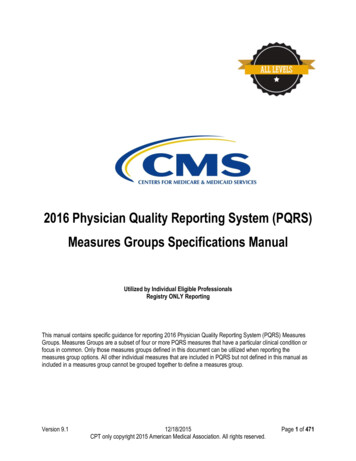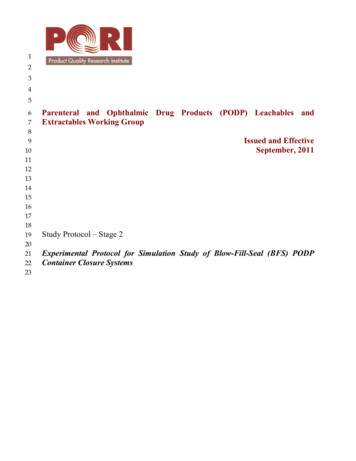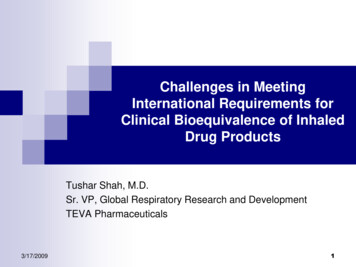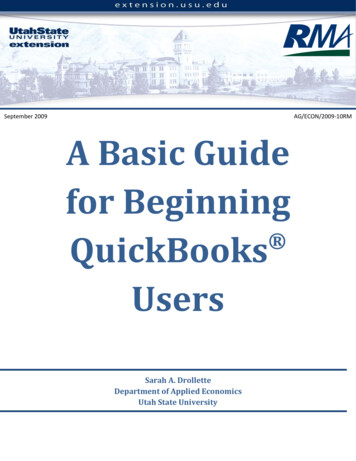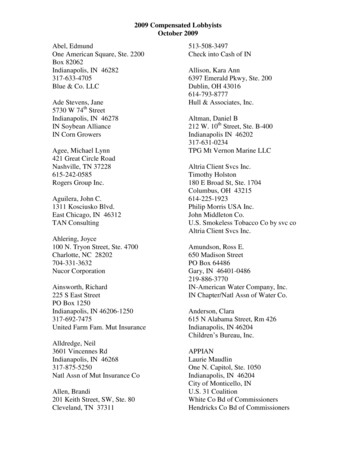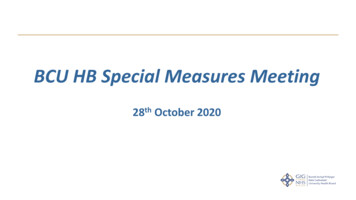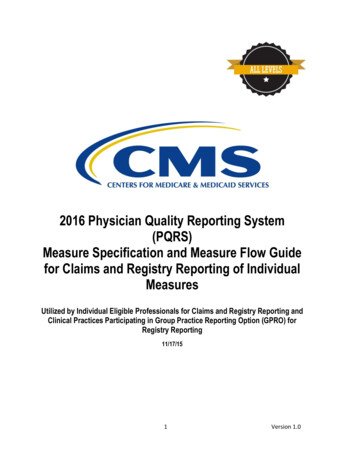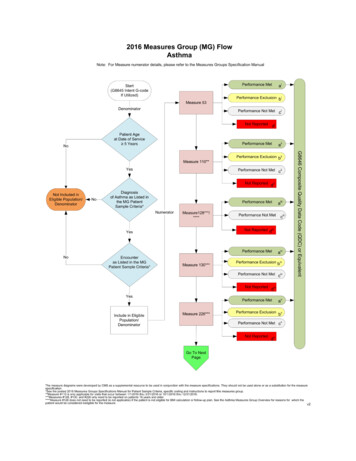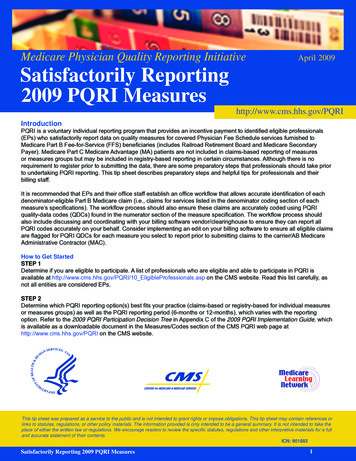
Transcription
Medicare Physician Quality Reporting InitiativeApril 2009Satisfactorily Reporting2009 PQRI I is a voluntary individual reporting program that provides an incentive payment to identified eligible professionals(EPs) who satisfactorily report data on quality measures for covered Physician Fee Schedule services furnished toMedicare Part B Fee-for-Service (FFS) beneficiaries (includes Railroad Retirement Board and Medicare SecondaryPayer). Medicare Part C Medicare Advantage (MA) patients are not included in claims-based reporting of measuresor measures groups but may be included in registry-based reporting in certain circumstances. Although there is norequirement to register prior to submitting the data, there are some preparatory steps that professionals should take priorto undertaking PQRI reporting. This tip sheet describes preparatory steps and helpful tips for professionals and theirbilling staff.It is recommended that EPs and their office staff establish an office workflow that allows accurate identification of eachdenominator-eligible Part B Medicare claim (i.e., claims for services listed in the denominator coding section of eachmeasure’s specifications). The workflow process should also ensure these claims are accurately coded using PQRIquality-data codes (QDCs) found in the numerator section of the measure specification. The workflow process shouldalso include discussing and coordinating with your billing software vendor/clearinghouse to ensure they can report allPQRI codes accurately on your behalf. Consider implementing an edit on your billing software to ensure all eligible claimsare flagged for PQRI QDCs for each measure you select to report prior to submitting claims to the carrier/AB MedicareAdministrative Contractor (MAC).How to Get StartedSTEP 1Determine if you are eligible to participate. A list of professionals who are eligible and able to participate in PQRI isavailable at http://www.cms.hhs.gov/PQRI/10 EligibleProfessionals.asp on the CMS website. Read this list carefully, asnot all entities are considered EPs.STEP 2Determine which PQRI reporting option(s) best fits your practice (claims-based or registry-based for individual measuresor measures groups) as well as the PQRI reporting period (6-months or 12-months), which varies with the reportingoption. Refer to the 2009 PQRI Participation Decision Tree in Appendix C of the 2009 PQRI Implementation Guide, whichis available as a downloadable document in the Measures/Codes section of the CMS PQRI web page athttp://www.cms.hhs.gov/PQRI on the CMS website.This tip sheet was prepared as a service to the public and is not intended to grant rights or impose obligations. This tip sheet may contain references orlinks to statutes, regulations, or other policy materials. The information provided is only intended to be a general summary. It is not intended to take theplace of either the written law or regulations. We encourage readers to review the specific statutes, regulations and other interpretive materials for a fulland accurate statement of their contents.ICN: 901883Satisfactorily Reporting 2009 PQRI Measures1
STEP 3Review the 2009 PQRI Measures List, which is available as a downloadable document in the Measures/Codes section ofthe CMS PQRI web page at http://www.cms.hhs.gov/PQRI on the CMS website, and determine which PQRImeasures apply.EPs who choose to report on individual measures need to select at least three measures to report on to be able to qualifyto earn a PQRI incentive payment.EPs who choose to report measures groups need to select at least one measures group to report to be able to qualify toearn a PQRI incentive payment for 2009.If you have already been participating in PQRI, there is no requirement to select new/different measures for PQRI 2009.Please note that all PQRI measure specifications are updated and posted prior to the beginning of each program year, soEPs will need to review them for any revisions.STEP 4Individual PQRI MeasuresOnce you have selected the measures (at least three), carefully review the following documents:1) 2009 PQRI Quality Measures Specifications Manual and Release Notes for claims-based or registry-based reportingof individual measures. You do not need to print the entire manual, just print the few pages that describe reporting andcoding specifications for your three measures.2) 2009 PQRI Implementation Guide, which describes important reporting principles underlying claims-based reporting ofmeasures and includes a sample claim in CMS-1500 format.Both documents can be found as downloadable documents in the Measures/Codes section of the CMS PQRI web page athttp://www.cms.hhs.gov/PQRI on the CMS website.As you read through the specifications and reporting instructions, you will notice that each of the measures has a QDC(a CPT II code or G-code) associated with it and several CPT II modifiers: generally 1P, 2P, and 3P. To qualify for theincentive, the correct QDC will need to be reported on at least 80 percent of the claims that are eligible for each selectedmeasure. A claim is “eligible” when the ICD-9-CM diagnosis and the CPT I service codes match the diagnosis and CPT Icodes listed for the measure denominator.You will also notice that each measure has a reporting frequency or timeframe requirement for each eligible patient seenduring the reporting period for each individual EP (National Provider Identifier [NPI]). The reporting frequency (i.e., reporteach visit, once during the reporting period, each episode, etc.) is found in the Instructions section of each measurespecification. Ensure that all members of the team understand and capture this information in the clinical record tofacilitate reporting.OR: As an alternative to reporting on at least three individual measures, you can select to report one or moremeasures groups.PQRI Measures GroupsOnce you have selected the measures group(s), carefully review the following documents:1) 2009 PQRI Measures Groups Specifications Manual for claims-based or registry-based reporting of measures groups.You do not need to print the entire manual, just print the few pages that have to do with the detailed coding specificationsfor your selected measures group(s). Note that the specifications for a measures group are different from those forindividual measures. Be sure you use the correct specifications.2) Getting Started with 2009 PQRI Reporting of Measures Groups – This is the implementation guide for reportingmeasures groups.3) 2009 PQRI Tip Sheet: PQRI Made Simple – Reporting the Preventive Care Measures Group – This tip sheet providesa useful worksheet to keep track of each patient reported when using the 30 consecutive patient sample method for ameasures group.You can find the first two documents as downloadable documents in the Measures/Codes section of the CMS PQRIweb page at http://www.cms.hhs.gov/PQRI on the CMS website. The third document can be found as a downloadabledocument in the Educational Resources section of the CMS PQRI web page.Satisfactorily Reporting 2009 PQRI Measures2
Tips for PQRI ReportingThe following tips are offered to assist professionals and their staff to submit PQRI measures accurately.Claims-based Reporting of Individual MeasuresEnsure all staff understand the measures you have selected to report. The primary authoritative sources formeasure specifications are those posted on the CMS PQRI website.It is important to review all the denominator codes that can affect claims-based reporting, particularly for broadlyapplicable measures or measures that do not have an associated diagnosis (for example, #110 influenzaimmunization, #154 Falls Risk Assessment, #47 Advance Care Plan, etc.) because you will need to report oneach eligible claim as instructed in the measure specifications.Ensure you identify and capture all eligible claims per the measure denominator for each measure selected. Notethat several measures apply broadly across various settings of care, (not only office practices but also hospitals,nursing homes, and home health agencies). For example, the table below shows some measuresthat include only CPT I service codes in the denominator; an ICD-9-CM diagnosis code is not required fordenominator inclusion. Therefore, each individual EP who chooses to report these broadly applicable measureswill need to report the QDC on each eligible claim that falls into the denominator. Failure to submit a QDC onclaims for these Medicare patients will result in a “missed” PQRI reporting opportunity that can impactincentive eligibility.Measure #TitlePQRI Reporting47Advance Care PlanReport a minimum of once for all patients aged 65 years and oldermeeting denominator encounter codes.110Preventive Care and Screening:Influenza Immunization forPatients 50 Years OldReport a minimum of once for all patients aged 50 years and oldermeeting denominator encounter codes.111Preventive Care and Screening:Pneumonia Vaccination forPatients 65 Years and OlderReport a minimum of once for all patients aged 65 years and oldermeeting denominator encounter codes.128Preventive Care and Screening:Body Mass Index (BMI)Screening and Follow-UpReport a minimum of once for all patients aged 18 years and oldermeeting denominator encounter codes.130Documentation and Verificationof Current Medications in theMedical RecordReport at each visit for all patients aged 18 years and older meetingdenominator encounter codes.For measures that require capturing clinical values for coding, make sure that these clinical values are availableto those who are coding claims for PQRI reporting.Some measures have specified patient demographics, such as age parameters and sex, fordenominator inclusion.For measures that you have selected to report, carefully review all ICD-9-CM diagnoses (if applicable) and CPTservice (encounter) codes that will qualify claims for inclusion in PQRI measurement calculations(i.e., claims that are denominator-eligible) to ensure that each claim includes the appropriate QDC(s) or QDCwith the allowable CPT II modifier with the individual EP’s NPI. Refer to the 2009 PQRI Implementation Guide. Ifthe diagnosis or encounter code is different than those listed in the PQRI denominator, then that measurewill not apply.For measures that require more than one QDC (CPT II or G-code), please ensure that all codes are capturedon the claim. For example, when submitting codes for Measure #3 - High Blood Pressure Control in DiabetesMellitus, be sure to include codes for both the systolic and diastolic blood pressure. Refer to the CMS-1500 ClaimSample in Appendix D of the 2009 PQRI Implementation Guide.Satisfactorily Reporting 2009 PQRI Measures3
If all billable services on the claim are denied for payment by the carrier/AB MAC, the QDCs will not be includedin PQRI analysis. The claim, as a whole, must include the payment codes, usually ICD-9-CM and CPT I orHCPCS codes, which supply the denominator as well as the QDCs, which supply the numerator in order for themeasure’s QDCs to be included in PQRI analysis. If the denied claim is subsequently corrected and paid throughan adjustment, reopening, or the appeals process by the carrier/AB MAC, with accurate codes that alsocorrespond to the measure’s denominator, then QDCs that correspond to the numerator should also be includedon that corrected claim as instructed in the measure specifications. Note that claims may not be resubmitted onlyto add or correct QDCs, and claims with only QDCs on them with a zero total dollar amount may not beresubmitted to the carrier. Remember that claim adjustments, reopenings, or appeals processed by thecarrier/AB MAC must reach the national Medicare claims system data warehouse (National Claims History[NCH] file) by February 28, 2010, to be included in the analysis.QDCs should be submitted on the line item of the claim as a zero charge or nominal amount such as a penny.The submitted charge field ( Charges) cannot be left blank. Since there is no allowed charge for the PQRI QDCline items, all PQRI QDC line items will be denied by the carrier claims processing system and passed ontothe NCH file for PQRI analysis and incentive payment eligibility calculation. The Remittance Advice (RA) withdenial code N365 is your indication that the PQRI codes were passed into the NCH file for use in calculatingincentive eligibility. Note: Claims may NOT be resubmitted solely to add QDCs. Review the measure specificationto determine the appropriate numerator codes to place on the claim. When applicable, utilize the 8P reportingmodifier (or G-code equivalent) when the action required is not performed and the reason is not otherwisespecified so that the claim will count toward satisfactory reporting.Check your RA regularly to ensure you receive a remark code N365 for each QDC submitted to ensure QDCs forindividual measures as well as measures groups were passed into the NCH. This remark does not confirmQDC accuracy.Claims-based Reporting of Measures GroupsThere are two reporting methods for submission of measures groups that involve a patient sample selection: either theConsecutive Patient Sample Method or the 80% Patient Sample Method. An “intent G-code” must be submitted for eithermethod to initiate your intent to report measures groups via claims.When reporting quality actions for the PQRI measures groups, the individual EP may report QDCs on eachindividual measure within the measures group OR report one (composite) G-code, which indicates that all qualityactions for all the measures in the group were performed (for example, G8494, indicates all quality actions for theapplicable measures in the diabetes mellitus measures group have been performed for the patient).If all of the quality actions for the measures within the measures group were performed at an encounter during thereporting period, the EP could report the composite G-code instead of reporting QDCs for each measureindividually. Note that performance exclusion modifiers (i.e., 1P, 2P, 3P, or G-code equivalent) and the 8Preporting modifier cannot apply to the reporting of any measure within the measures group if the compositeG-code is used for reporting because all of the quality actions for each measure must have been performed anddocumented. Refer to the CMS-1500 Claim Examples-Measures Groups posted on the Measures/Codes sectionof the CMS PQRI website.For the consecutive patient sample method, “consecutive” refers to how you select the sample or cohort ofpatients eligible for a measures group and consists of patients who were seen on consecutive dates of serviceby the EP who has selected to report a measures group. If the patient selected in the sample returns at asubsequent encounter, a QDC may be added to that subsequent claim to indicate that the clinical action wasperformed during the reporting period. PQRI analysis will consider all QDCs submitted across multiple claims forpatients in the consecutive sample.EPs need to only report the applicable measures for each patient that meets denominator inclusion in theconsecutive patient sample. Denominator inclusion of the patient sample for both the Consecutive Patient SampleMethod and the 80% Patient Sample Method is determined by diagnosis and/or encounter parameters commonto all measures within a selected measures group. For example, if patient #3 in the sample does not meet the agerequirements for all of the measures within the measures group, report those measures that ARE applicable topatient #3. All patients may not meet all of the measure criteria within the measures group.Satisfactorily Reporting 2009 PQRI Measures4
EPs who have contracted with MA Plans should not include their MA patients in claims-based reporting ofmeasures groups using the Consecutive Patient Sample method. Only Medicare Part B FFS patientsshould be included in claims-based reporting of measures groups using the Consecutive Patient Sample Method.Common Reporting Errors Associated with Claims-based ReportingNo QDC submitted on an eligible claim. Failure to submit a QDC on claims for these Medicare patients will resultin a “missed” PQRI reporting opportunity that can impact incentive eligibility.Eligible claim without an individual NPI or with the NPI incorrectly placed on the claim will result in a claimrejection by the carrier and will not be included in PQRI analysis.Eligible claim submitted as a QDC-only claim (no denominator information is accompanied).QDC submitted on a denominator-ineligible claim for the PQRI measure:- Diagnosis is incorrect on claim for measure reported,- Encounter code is incorrect on claim for measure reported, and- Age/gender on claim is incorrect for measure reported.Billing software does not allow enough lines on the claim and splits claim.Registry-based Reporting of Individual Measures or Measures GroupsSubmission of at least three individual measures or at least one measures group via registry is governed by the 2009PQRI Quality Measures Specifications Manual and Release Notes and 2009 PQRI Measures Groups Specifications Manual,respectively. The qualified registry is responsible for providing their clients with instructions on how to submit the selectedmeasures or measures group through the registry. Information regarding qualified registries can be found on the Reportingsection of the CMS PQRI website. Note: 18 PQRI measures and 1 measures group are reportable through theregistry-based reporting option only.Registry-based reporting for measures groups may include Medicare Part B FFS patients as well as non-Medicarepatients when reporting using the Consecutive Patient Sample Method.EPs reporting measures groups via the Consecutive Patient Sample Method via registry must report on all patients withinthe sample, regardless of payer.Medical Record DocumentationEPs should document fulifllment of measure requirements in the medical record.CMS PQRI Tip Sheet ReferencesCMS/PQRI Website Location2009 PQRI Fact Sheet: What’s New for the 2009 PQRIEducational Resources DownloadEligible Professionals ListEligible Professionals section2009 PQRI Implementation GuideAppendix A: Glossary of TermsAppendix B: Sample 2009 PQRI MeasureAppendix C: 2009 PQRI Participation Decision TreeAppendix D: CMS-1500 Claim ExampleMeasures/Codes Download2009 PQRI Quality Measures ListMeasures/Codes Download2009 PQRI Quality Measures Specifications Manual andRelease NotesMeasures/Codes Download2009 PQRI Measures Groups Specifications ManualMeasures/Codes DownloadGetting Started with 2009 PQRI Reporting of Measures GroupMeasures/Codes DownloadCMS 1500 Claim Examples-Measures GroupsCMS Educational Resources Download2009 PQRI Tip Sheet: PQRI Made Simple-Reporting PreventiveCare Measures GroupCMS Educational Resources Download2009 PQRI Patient-Level Measures ListCMS Educational Resources DownloadInformation and Materials for National Provider Calls& Open Door ForumsCMS Sponsored Calls web pageFAQsPQRI FAQs - Related Links Inside CMS, bottomof PQRI web pageSatisfactorily Reporting 2009 PQRI Measures5
measure’s specifications). The workflow process should also ensure these claims are accurately coded using PQRI quality-data codes (QDCs) found in the numerator section of the measure specification. The workflow process should also include discussing and coordinating with your billing so
